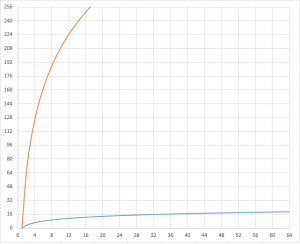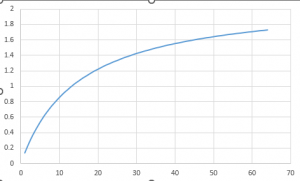机械动力机器数值分析
冬季救援整合包里面的应力相对来说获取困难。为了极致地利用应力以及做好机器匹配,我查阅了相关代码并对其进行了分析。由于本人代码水平也不是很好,也没有编写java的经验,难免有解读错误的地方,望大佬继续补充。
开始
1 基础
1秒是20gametick(20t)
2 粉碎轮
分析
粉碎轮速度相关的代码为
inventory.remainingTime = recipe.isPresent() ? recipe.get().getProcessingDuration() : 100;
crushingspeed = compound.getFloat("Speed");
float speed = crushingspeed * 4;
float processingSpeed =Mth.clamp((speed) / (!inventory.appliedRecipe ? Mth.log2(inventory.getStackInSlot(0).getCount()) : 1), .25f, 20);
inventory.remainingTime -= processingSpeed;
其中crushingspeed就是我们给的转速/12.5,这个速度取速度慢的轮,所以我们统一按两轮等速讨论
每次处理所需要的总进度如果配方有写就按配方,没有就是100(一般都是100)
首先看条件,假如已经吸入了物品(即不是掉落物形态),除数为log2(物品数量),否则按1
但实际上这个没啥用,因为我们都采用溜槽等方式直接跳过了吸入过程,去除了吸入所需时间,因此我们直接按着已吸入计算即可
clamp的作用是限定范围,高于最大值就等于最大值,小于最小值就等于最小值,这里的上下限是0.25和20
为了方便讨论,我们提出一个问题,假设我要总共处理a个物品,可用应力为定值b,单个机器单次处理y个,转速x,求处理总用时t
已知单个机器(两个粉碎轮)rpm为16,由此可以得可用机器数量k=b/16x
我们先假设clamp函数不起作用,不难列出如下公式
其中a,b,T=100为问题一开始就确立的定值,可操作变量为x,y
易得处理总时在一定的总应力下与转速无关,单个机器单次处理量越大处理总需时越小
在这个结论的基础上我们再讨论clamp函数的影响
易知单个机器处理初始速度为
另v分别等于0.25与20,我们可以得出,上方公式的适用范围
高于红线则转速无效,低于蓝线则有增益
人话
在确定总应力下,处理耗时只与单次处理量有关
直接用智能溜槽喂64是最佳选择
粉碎轮转速调成1即可
单位时间产量与转速成正比,1速64堆叠下粉碎轮每秒可处理3.2个物品
3 辊压机
分析
public static final int CYCLE = 240;
prevRunningTicks = runningTicks;
runningTicks += (int) Mth.lerp(Mth.clamp(Math.abs(speed) / 512f, 0, 1), 1, 60);
if (prevRunningTicks < CYCLE / 2 && runningTicks >= CYCLE / 2)
runningTicks = CYCLE / 2;
if(runningTicks > CYCLE)
完成()
这里的speed就直接是转速了
lerp函数作用是将0-1小数等比放大到一定范围内
由于cycle很小,mc又按t计算,因此处理速度是阶跃的
观察易得其为两个120的阶跃进度,因此处理速度需要为120的因数才最好,用excel可轻松求出阶跃转速
人话
下表转速为最佳转速,自行选取即可
| 转速 | 增速 | 需时(tick) | 筛选 | 产量(每秒) |
| 1 | 1 | 120 | 120 | 0.166666667 |
| 9 | 2 | 60 | -60 | 0.333333333 |
| 18 | 3 | 40 | -20 | 0.5 |
| 27 | 4 | 30 | -10 | 0.666666667 |
| 35 | 5 | 24 | -6 | 0.833333333 |
| 44 | 6 | 20 | -4 | 1 |
| 53 | 7 | 18 | -2 | 1.111111111 |
| 61 | 8 | 15 | -3 | 1.333333333 |
| 70 | 9 | 14 | -1 | 1.428571429 |
| 79 | 10 | 12 | -2 | 1.666666667 |
| 87 | 11 | 11 | -1 | 1.818181818 |
| 96 | 12 | 10 | -1 | 2 |
| 113 | 14 | 9 | -1 | 2.222222222 |
| 122 | 15 | 8 | -1 | 2.5 |
| 148 | 18 | 7 | -1 | 2.857142857 |
| 165 | 20 | 6 | -1 | 3.333333333 |
| 200 | 24 | 5 | -1 | 4 |
| 252 | 30 | 4 | -1 | 5 |
4 鼓风机
分析
public final ConfigInt fanPushDistance = i(20, 5, "fanPushDistance", Comments.fanPushDistance);
public final ConfigInt fanRotationArgmax = i(256, 64, "fanRotationArgmax", Comments.rpm, Comments.fanRotationArgmax);
float distanceFactor = Math.min(speed / config.fanRotationArgmax.get(), 1);
float pushDistance = Mth.lerp(distanceFactor, 3, config.fanPushDistance.get());
这上面4是控制距离的,阅读易得距离k=speed/256*17+3
.
float sneakModifier = entity.isShiftKeyDown() ? 4096f : 512f;
float speed = Math.abs(source.getSpeed());
float acceleration = (float) (speed / sneakModifier / (entityDistance / maxDistance));
这3控制吹生物速度,没啥用
.
public final ConfigInt inWorldProcessingTime = i(150, 0, "inWorldProcessingTime", Comments.inWorldProcessingTime);
int timeModifierForStackSize = ((entity.getItem().getCount() - 1) / 16) + 1;
int processingTime = (int) (AllConfigs.SERVER.kinetics.inWorldProcessingTime.get() * timeModifierForStackSize) + 1;
int value = processing.getInt("Time") - 1;
processing.putInt("Time", value);
这堆是控制处理时间的,一叠物品的总处理时间是... ((数量-1)/16+1)*150... tick
将处理时间乘处理数量即为处理效率,使用excel轻松得
可见单堆物品数量越多,处理越快,最快速度为每秒1.73个物品
人话
鼓风机速度只影响吹风距离,一速够了
吹炼的物品堆满64一组,这样最快



